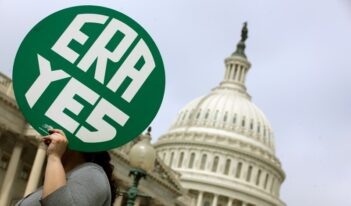
Scholars, activists, and other criminal justice experts address possible legal responses to excessive police force.
Over two years ago, in Ferguson, Missouri, an unarmed African-American teenager named Michael Brown was fatally shot by a white police officer. The incident unleashed a wave of protests and led to an investigation by the U.S. Department of Justice that detected patterns of excessive police force in Ferguson, with close to 90 percent of force being used on individuals of color.
The Ferguson shooting elevated national awareness surrounding use of force by police. Soon after Ferguson, polls revealed a lack of public confidence in officers’ abilities to use the appropriate level of force in a given situation. And with continuing media reports on additional police shootings of unarmed minority individuals, it is no surprise that public confidence in police has reached its lowest point in years.
Law enforcement officials have also turned their attention to incidents of police use of force. James Comey, the Director of the Federal Bureau of Investigation, has pointed to the lack of national data on use-of-force events and has stated that obtaining this information is a critical step in addressing unnecessary police force. Some of the country’s police chiefs are beginning to put polices in place that aim to lower the number of deadly shootings by police, citing the need to address excessive police use of force.
Against this backdrop of increasing national attention to police use of force, The Regulatory Review presents a series of essays that analyze the issues and possible solutions to excessive force by law enforcement officials.
The series begins with an essay by Kami N. Chavis, Professor of Law, Associate Dean of Research and Public Engagement, and Director of the Criminal Justice Program at Wake Forest University School of Law. Essays by other contributors, including leading criminal justice scholars and activists, former law enforcement officers, and public officials, will follow.
The Future of Police Reform Under the Trump Administration
February 13, 2017 | Kami N. Chavis, Wake Forest School of Law
By 2016, the country seemed poised to experience a “criminal justice revolution,” as many municipal police departments and local officials promised the communities they served that they would implement reforms. Yet, during his presidential campaign, President Donald Trump effectively took a swipe at these efforts. The federal role in police accountability will likely decrease, which is less than ideal, but is not alarming for several reasons.
Regulating the Reasonableness of Police Violence
February 14, 2017 | Seth W. Stoughton, University of South Carolina School of Law
The Fourth Amendment rules governing police use of force provide little guidance, and even this guidance is often sloppily applied. “Objective reasonableness” is an appropriate touchstone for regulating force, but the ill-informed Graham v. Connor standard will need to be replaced by more meaningful rules if the nation is to solve its crisis of confidence over law enforcement.
Reviewing Police Use of Force Through Root Cause Analysis
February 15, 2017 | John F. Hollway, Quattrone Center for the Fair Administration of Justice, University of Pennsylvania Law School
Recently, law enforcement and criminal justice agencies across the country have begun to embrace a new type of event review, which posits that when our law enforcement system generates undesirable events, we should review those events first to understand why events unfolded the way they did, rather than reviewing them to understand who is responsible.
How Transportation Safety Review Can Play a Role in Regulating Law Enforcement
February 16, 2017 | Paul Heaton, Quattrone Center for the Fair Administration of Justice, University of Pennsylvania Law School
Could a new independent agency that is patterned after the National Transportation Safety Board (NTSB) and tasked with investigating police violence help address public concerns about police use of force? Quite possibly. It could adopt features of the NTSB approach, whose investigations are forward-looking and focus on ways to prevent similar accidents.
Closing the Courthouse Door to Victims of Police Abuse
February 20, 2017 | Erwin Chemerinsky, University of California, Irvine School of Law
The U.S. Supreme Court deserves some of the blame for the problem of police misconduct. In spite of the crucial role that civil liability plays in deterring police misconduct, the Court has created enormous obstacles to holding officers civilly liable. It has fashioned a number of doctrines that make it very difficult for citizens to sue police officers or the government entities that employ them.
The Dangers of Stop-and-Frisk Policies
February 21, 2017 | Clemmie Harris, Syracuse University
As an advisor to New York Governor David A. Paterson, I worked on legislation that prevented the electronic warehousing of identifying information of individuals stopped under the New York City Police Department’s stop-and-frisk policy, but were not charged with crimes. In my view, recording this information of African Americans and Latinos—who constituted a majority of those stopped but not arrested—was tantamount to racial profiling.
Reporting Police Force in the Digital Age
February 22, 2017 | Everett Wetchler, Bayes Impact
In 2015, California passed legislation that requires every law enforcement agency in California to report all police shootings and incidents where a civilian or officer is seriously injured or dies due to force. Nonprofit startup Bayes Impact built an online tool called URSUS to collect these data. After months of chiseling, officers were routinely blown away by the final product’s simplicity and intuitive nature.
Disability and Policing
February 23, 2017 | Britney Wilson, Center for Constitutional Rights
Issues of both race and disability should be analyzed when addressing police brutality. There is a general recognition that police reform should include changes concerning people with disabilities, particularly with respect to equipping law enforcement officials to address challenges facing people with mental disabilities. However, larger questions still remain about whether police departments are fulfilling their basic duties to accommodate people who have disabilities.
The Troubling Issues Regarding Police Use of Force
February 27, 2017 | David Rudovsky, University of Pennsylvania Law School
Although most police-civilian interactions do not involve unreasonable force, the video-documented incidents of excessive force have moved the debate from one of “is there a problem” to the scope of excessive force. This debate provides an opportunity to correct constitutional and operational standards in an area that poses challenges to our commitment to restraints on necessary but widely abused governmental powers.
The Need for a Trauma-Informed Approach to Female Incarceration
February 28, 2017 | Vivian Nixon, College and Community Fellowship
Although men make up the majority of the prison population, rates of women’s incarceration have now outpaced male incarceration at an astonishing pace of two to one since 1980. This drastic increase of more than 700 percent firmly secures women’s place as the fastest growing prison population and highlights the urgent need for a gender-responsive, trauma-informed approach to female incarceration in the United States.
A Policing Model For the 21st Century
March 1, 2017 | Marq Claxton, Black Law Enforcement Alliance
The policing model for the 21st century is fertile ground for attention, focus, and debate on the use of force by police. What many believe to be an outdated and antiquated methodology for fighting crime, maintaining public safety, and defending constitutional protections, is fraught with liabilities and danger for the professional police officer. There must be national professional standards for law enforcement coupled with a higher level of accountability.
Making Criminal Justice Pay
March 2, 2017 | Richard A. Bierschbach, Cardozo Law School
Police and other law enforcement systematically overuse force in part because few mechanisms require them to consider the social costs of doing so. Policymakers use a wide range of regulatory tools and strategies to combat externalities outside of criminal justice, including cost-benefit analysis in regulation. This essay considers how criminal justice might look if we brought such tools to bear on policing and punishment.
Move Criminal Justice Forward
March 6, 2017 | Tracey Meares, Yale Law School
Police officers earn their legitimacy when they treat people with what we call procedural justice. When people perceive the police as treating them fairly, and as having goals that are similar to their own, they are more likely to cooperate with the police to co-produce safety and order. It is this kind of policing—and this positive vision of public safety—that I believe our nation wants and needs.
Penn Panel Addresses Police Use of Force
March 7, 2017 | Sara Bodnar, University of Pennsylvania Law School
In an effort to spur dialogue over possible solutions to excessive police force, the University of Pennsylvania Law School Chapter of the American Constitution Society convened a panel of criminal justice experts to discuss this pressing issue. The panelists highlighted the impact of deadly police force on communities of color and also recommended strategies to reduce violent events involving police.
Evaluating Police Use of Force
March 9, 2017 | Cecil Thomas, Ohio State Senate
Community unrest surrounding recent officer-involved deaths of unarmed citizens has resulted in a national trend of states and police departments reevaluating their procedures to improve transparency, accountability, and community involvement. Pulling from statewide examples, particularly that of Ohio, I will present steps taken so far in regulating police use of force, in hopes of building a framework that others can follow concerning these changes.



